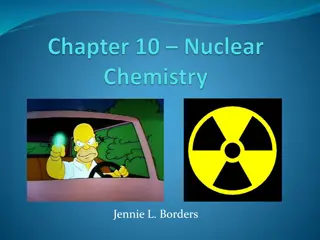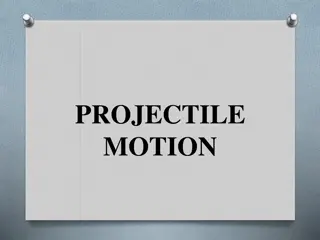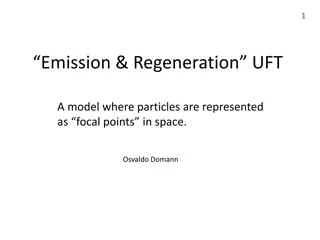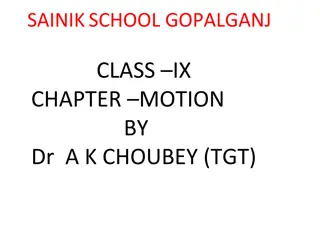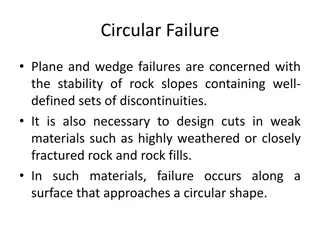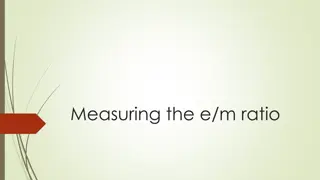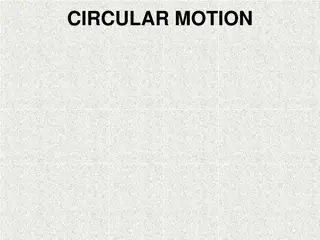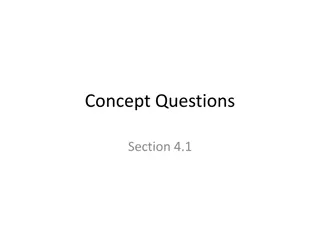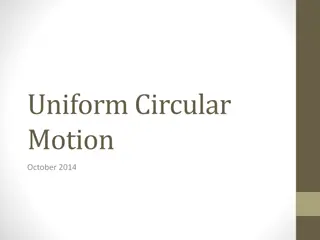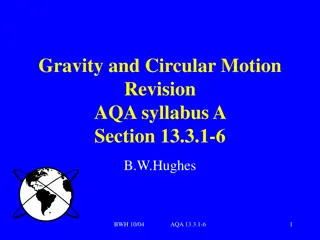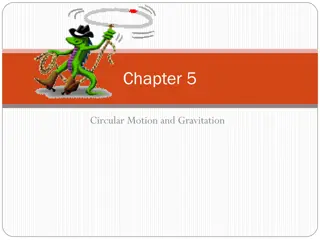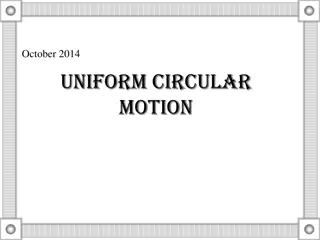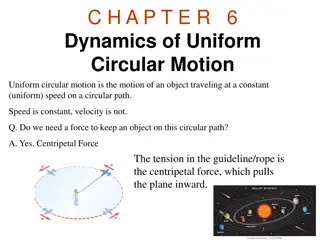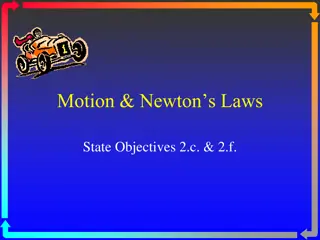
Newton's Laws of Motion in Classical Mechanics
Explore the applications of Newton's laws in analyzing particles in equilibrium, dynamics of particles, frictional forces, and circular motion. Gain insights into balancing forces in static and dynamic situations, solving equilibrium problems, and understanding the relationship between forces and motion. Dive into the foundational principles of force and its applications in physical systems.
Download Presentation

Please find below an Image/Link to download the presentation.
The content on the website is provided AS IS for your information and personal use only. It may not be sold, licensed, or shared on other websites without obtaining consent from the author. If you encounter any issues during the download, it is possible that the publisher has removed the file from their server.
You are allowed to download the files provided on this website for personal or commercial use, subject to the condition that they are used lawfully. All files are the property of their respective owners.
The content on the website is provided AS IS for your information and personal use only. It may not be sold, licensed, or shared on other websites without obtaining consent from the author.
E N D
Presentation Transcript
Applications of Newtons Laws Outline Particles in Equilibrium Dynamics of particles Frictional forces Dynamics of circular motion 1
Introduction The Newton s laws of motion are the foundation of classical mechanics and it can be stated a very simply manner. But applying these laws to situations such as real time situations such as a toboggan sliding down a hill, or an airplane making a steep turn requires analytical skills and problem-solving technique. We ll begin with equilibrium problems, in which we analyze the forces that act on a body at rest or moving with constant velocity (Particles in Equilibrium); We ll then consider bodies that are not in equilibrium, for which we ll have to deal with the relationship between forces and motion (Dynamics of particles); We ll learn how to describe and analyze the contact force that acts on a body when it rests on or slides over a surface (Frictional forces); and We ll also analyze the forces that act on a body that moves in a circle with constant speed. We shall close the lecture with a brief look at the fundamental nature of force and the classes of forces found in our physical universe (Dynamics of circular motion). 2
Particles in Equilibrium A body under the influence of forces is called a particle. It is said to be at equilibrium when it is at rest or moving with constant velocity in an inertial frame of reference. Examples: A hanging lamp, a kitchen table, an airplane flying straight and level at a constant speed. The essential physical principle is Newton s first law: When a particle is in equilibrium, the net force acting on it that is, the vector sum of all the forces acting on it must be zero: 3
Particles in Equilibrium i Two 250 N wieghts are suspended at opposite ends of a rope which passes over a light frictionless pulley is atteched to a chain which goes to the ceiling. Determine the tension in the chain. Solution: Let Tw be the tension cause by each weight and the Tc is the tension on the chain by the ceilingon the pulley. The net force on the pulley is: Tc (Tw1+Tw2) = 0 Tc = Tw1 + Tw2 = 250 +250 Tc= 500 N ii A wieght of 250 kg is suspended vertically from two strings as shown below at point O. If the tension in the right string is 183 kg. Determine the tension T. 30o Tc Tw1 Tw2 250N 250N Solution The forces acting on the wight are shown in the second figure, For Equilibrium, vetical resolution of forces gives: 183Cos60o+TCos(90- )-250=0; TSin =158.5 Horizontal resolution gives 183Sin60o+TSin(90- )-250=0; TCos =158.5 T2 (Sin2 +Cos2 )=158.52 + 158.52 T=224.1 kg; =tan-1(158.8/158.5)=45o. 30o T 183 kg 60o 4 250kg
Dynamics of particles A body is said to be dynamics when the net force is NOT equal to zero. applicaton of Newton s second law in which the velocity of bodies in motion constant. These bodies are not in equilibrium and hence are accelerating. The net force on the body is equal to the mass of the body times acceleration: You have to use Newton s second law for any problem that involves forces acting on an accelerating body. This is is not its 5
Impulse and Momentum An impulse is the product of the force and the time in which the force acts while the momentum is the product of the mass and the velocity of the body. A body that increases its velocity from u to v within an interval of time t acquires an acceleration: a=v-u and the force acting on the body is: F=m(v-u) t Therefore, Ft=mv-mu The above equation states that the impulse on a body is equal to the change in momemtum of the body. Considering a body A of mass mA with initial velocity uA and collides with a second body B of mass mB and initial velocity uB. if the velocities of A and B after collition are vA and vB respectively, t 6
Solved problems Then, Initial momentum of A and B is equal to final momemtum of A and B mAuA+mBuB= mAvA+mBvB This is the principle of concervation of momentum which states that, the total momentum of a system remein constant if no external force act on the system. Example 1. An upward force of 1.2x104N acts on an elevator of mass 2.0x103 kg. Calculate the elevator s accelation. Solution The forces acting on the elevator are its weight, mg, downwards and upward force F. The net force is F-mg=ma 1.2x104-(2.0x103 x 9.8) =( 2.0x103)a a= -3.8m/s2 F a mg Physics chapter 5 7
Frictional forces Whenever two bodies interact by direct contact (touching) of their surfaces, we describe the interaction in terms of contact forces. The normal force is one example of a contact force; in this section we ll look in detail at another contact force, the force of friction. Friction is important in many aspects of everyday life. The oil in a car engine minimizes friction between moving parts, but without friction between the tires and the road we couldn t drive or turn the car. Air drag the frictional force exerted by the air on a body moving through it decreases automotive fuel economy but makes parachutes work. Without friction, nails would pull out and light bulbs would unscrew effortlessly. Kinetic and Static Friction When you try to slide a heavy box of books across the floor, the box doesn t move at all unless you push with a certain minimum force. Then the box starts moving, and you can usually keep it moving with less force than you needed to Physics chapter 5 8
Friction When you slide a heavy box across the floor You have to push with a strong enough force to get it moving. Once it is moving, you can keep it moving with less force than it took to get it started. If you make the box lighter, you need less force than before to start it and to keep it moving. Physics chapter 5 9
Forces from a surface When an objects rests or slides on a surface, The surface exerts a normal force perpendicular to the surface And a frictional force parallel to the surface. The direction of the frictional force is such that it always opposes the relative motion of the two surfaces. Physics chapter 5 10
Kinetic Friction The frictional force that acts when a body slides over a surface is called kinetic friction. Its magnitude is given by: Magnitude of normal force = f F k k N Coefficient of kinetic friction 11
Static Friction The frictional force that acts on a body that is resting on a surface is called static Friction. Static friction is what resists the beginning of motion and makes it hard to get a box started sliding across the floor. The magnitude of static friction force is: Magnitude of normal force F f = s s N Coefficient of static friction 12
Frictional forces Example 1: A box of books of mass 2.0 kg is sliding across a level floor and its retardation is measured to be 4.0 m/s2. Calculate the cosfficient of kinetic friction. Solution N Resolving verically gives N=mg a The only horizontal force on the book is ukN=ma, ukN a=4.0m/s2; Dividing equation 1 by 2 uk=a/g=4.0/9.8=0.408 mg 13
Dynamics of circular motion and gravitations Centripetal Acceleration: Many rigid bodies move in a circular path such as car negogiating a bend; the revolution of the satellites around the earth and the revolution of the planets around the sun. The acceleration of the circular moving body is directed radially towards the center of the circle and its magnitude is ; where r is the radius of the path. From Newton s 2nd law, Periodicity of the uniform acceleration: This is the time (T) taken for the particle to complete one revolution around the circular path of radius r. This is equal to the circumference of the circle divided by the speed. v ac=v2 r Fc=mac=mv2 r T =2pr 14
Newtons law of gravitation: This states that the force of attraction of two bodies in the universe is proposional to the product of their masses and inversely proportional to the square of the distance separating their centres. Fg=Gm1m2 r2 Gravitational Potential Energy V(E): This is the work done in moving a body initialy separated from the center of the earth by distance r is moved further distance dr. dW = Fgdr V(E)=-GMEm r dW = Fgdr GmME r2 r2 wgrav= = fg.dr dr r1 Thus a body on the surface of the Earth has a gravitational potential energy of while one at infinit distance from the earth zero gravitational potential energy -GMEm r 15
Recap The coefficients of friction, both static and kinetic, have no units. The coefficients of friction must be less than 1. When the net force on a particle is zero The particle is in equilibrium. It has a constant velocity. It has zero acceleration. When the net force on a particle is not zero The particle is dynamic The velocity is not constant The particle possesses accelaration In uniform circular motion, the acceleration vector is directed toward the center of the circle. The motion is governed by Newton s second law 16
Assignment 1. A 52-N sled is pulled across a cement sidewalk at constant speed. A horizontal force of 36 N is exerted. What is the coefficient of kinetic friction between the sidewalk and the metal runners of the sled? 2. The sled from the example is now on packed snow. The coefficient of friction is 0.12. If a person weighing 650 N sits on the sled, what force is needed to slide the sled across the snow at a constant speed? 3. A 100-N body is shown suspended from a system of cords. What is the tension in the horizontal cord? 45 4. A skier of mass 65.0 kg is pulled up a snow- covered slope at constant speed by a tow rope that is parallel to the ground. The ground slopes upward at a constant angle of 26 above the horizontal and you can ignore friction. Calculate the tension in the tow rope. 90 17
5. A man is dragging a trunk up the loading ramp of a movers truck. The ramp has a slope angle of 20.0 and the man pulls upward with force F whose direction makes an angle of 30.0 with the ramp. How large a force F is required in order for the component Fx parallel to the ramp to be 28.0 N? How large will the component Fy then be? 6. A 20-kg box rests on a frictionless ramp with a 15 slope. A mover pulls up on a rope attached to the box to pull it up the incline. If the rope makes an angle of 40 with the horizontal, what is the force the mover must exert on the box to give it an acceleration of 1m/s2? 7. A 5-kg block is held at rest against a vertical wall by a horizontal force. What is the minimum horizontal force needed to prevent the block from falling if the coefficient of friction between the wall and the block is s=0.40? 18

